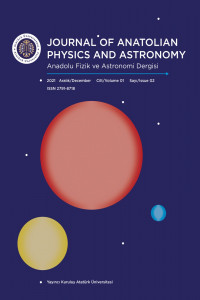Antimonun 59.54 keV'de L Alfa ve L Beta X-Işınlarının Açısal Dağılımı
Antimon, Saçılma Açısı, L X-ışınları, Anizotropi, Hizalama
Angular Distribution of L Alpha and L Beta X-Rays of Antimony at 59.54 keV
Antimony, Scattering Angle, L X-rays, Anisotropy, Alignment,
___
- [1]Cooper J, Zare N. Potoelectron angular distributions. In:Geltman, S., Mahanthappa,K.T., Brittin, W.E. (Eds.), Lectures in Theoretical Physics: Atomic Collision Processes, vol. X1C. Gordon and Breach, 1969.
- [2]Flügge S, Mehlhorn W, Schmidt V. Phys. Rev. Lett. 1972; 29 (1):7-9.
- [3]Mehlhorn W. Nucl. Instrum. Methods Phys. Res.B.1994;87(1-4): 227-31.
- [4]Mc Farlane SC. J. Phys. B At. Mol. Opt. Phys. 1972; 5:1906-15.
- [5]Berezhko EG, Kabachnik NM. J. Phys. B: At. Mol. Opt. Phys. 1977;10:2467-77.
- [6]Sizov V, Kabachnik NM. J. Phys. B: At. Mol. Opt. Phys. 1980; 13:1601.
- [7]Schöler A, Bell F. Z. Phys. A 1978; 286:163-68.
- [8]Pálinkás J, Schlenk B, Valek A. J. Phys. B: At. Mol. Opt. Phys. 1981; 14: 1157-59.
- [9]Wigger J, Altevogt H, Brüssermann M, Richter G, Cleff, B. J. Phys. B: At. Mol. Opt. Phys. 1984; 17:4721. [10] Jesus AP, Ribeiro JP, Niza IB, Lopes JS. J. Phys. B: At. Mol. Opt. Phys. 1989; 22:65.
- [10]Jesus AP, Ribeiro JP,Niza IB, Lopes JS. Phys. B: At. Mol. Opt. Phys.1989;22:65.
- [11]Mitra D, Sarkar M, Bhattacharya D, Chatterjee MB, Sen P, Kuri G., Mahapatra, et al. Phys. Rev.A.1996; 53:2309-13.
- [12]Hardy J, Henins A, Bearden JA. Phys. Rev. A. 1970; 2:1708-10.
- [13]Döbelin E, Sandner W, Mehlhorn W. Phys. Lett.A.1974; 49:7-8.
- [14]Stachura Z, Bosch F, Hambsch FJ, Liu B, Maor D, Mokler PH, et al. J. Phys. B: At. Mol. Opt. Phys. 1984; 17: 835-47.
- [15]Bhalla CP. Phys. Rev. Lett. 1990; 64:1103-106.
- [16]MehlhornW. Nucl. Instrum. Methods Phys. Res.B.1994; 8: 7227-233.
- [17]Papp T. Nucl. Instrum. Methods Phys. Res. B. 1999;154:300-306.
- [18]Requena S, Williams S. Radiation Physics and Chemistry. 2011;80:629-31.
- [19]Kumar A, Agnihotri AN, Misr D, Kasthurirangan S, Sarkadi L, Tribedi LC. J. Phys. B: At. Mol. Opt. Phys. 2012; 45: 215205.
- [20]Sharma A, Mittal R. Journal of Nuclear Physics, Material Sciences, Radation and Application. 2013; 1:83-101.
- [21]Sestric G, Ferguson S, Wright I, Williams S. Radiat. Phys. Chem. 2014; 102: 40-43.
- [22]Kumar A, Agnihotri AN, Misra D., Kasthurirangan Sarkadi SL, Tribedi LC. J. Phys. B: At. Mol. Opt. Phys. 2015; 48: 065202.
- [23]Wang X., Xu Z, Zhang Y, Ma C, Zhu C. Radiat. Phys. Chem. 2016;125: 102-105.
- [24]Gerward L, Guilbert N, Jensen KB, Levring H. Radiat. Phys. Chem. 2004;71: 653-54.
- [25]Scofield JH. Report No. URCL 51326. Lawrence Livermore Laboratory, Livermore, CA.1973;1-375.
- [26]Hubbell JH, Trehan PN, Singh N, Chand B, Mehta D, Garg ML, et al. Journal Physics and Chemistry Ref. Data. 1994; 23: 339-64.
- [27]Scofield J.H. Atomic Data Nuclear Data Tables. 1974; 14(2): 121-37.[28]Krause MO. J. Phys. Chem. Ref. Data. 1979; 8:307-27.
- Başlangıç: 2021
- Yayıncı: Atatürk Üniversitesi
Sevil PORİKLİ DURDAĞI, Ahmed Hasan Hashim AL-JALAWEE, Fatma GÜZEL
ATA50 Teleskobunda Gece Gökyüzü Kalitesi Ölçümleri
Antimonun 59.54 keV'de L Alfa ve L Beta X-Işınlarının Açısal Dağılımı
Tuba AKKUŞ, Mesut ALKAN, Yusuf ŞAHİN
Ashalul MOHAMUD, Fatima ALLOGHANİ, Waad ALHUSSEİN, Shams A.m. ISSA, Hüseyin Ozan TEKİN
Koronagrafın Astronomideki Uygulamaları
Burak Batuhan GÜRBULAK, İlham NASIROĞLU, Aykut ÖZDÖNMEZ, Hüseyin ER
GaTe Tek Kristalinin Sıcaklığa Bağlı Optik Karekterizasyonu
Bekir GÜRBULAK, Mehmet ŞATA, Afsoun ASHKHASI, Burcu AKÇA, Songül DUMAN
